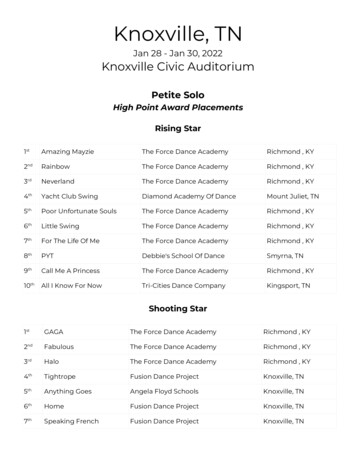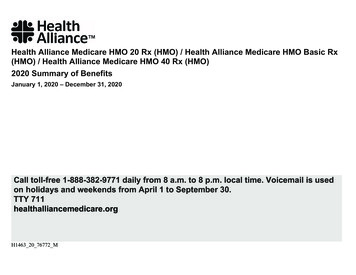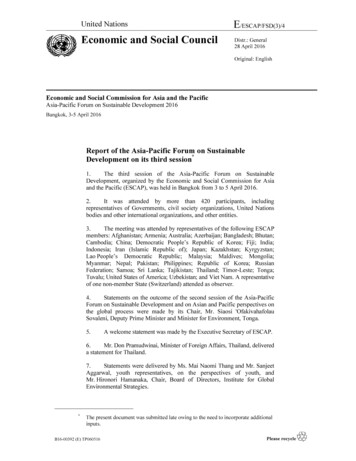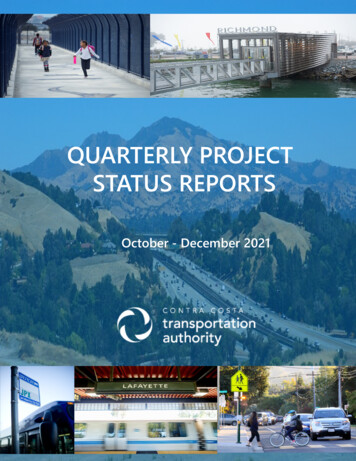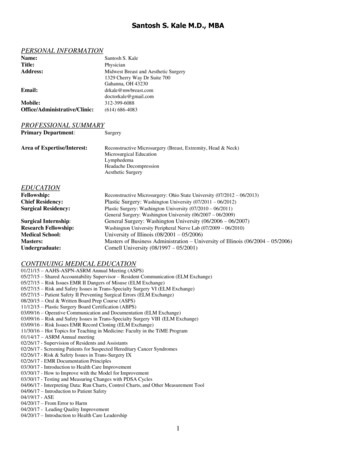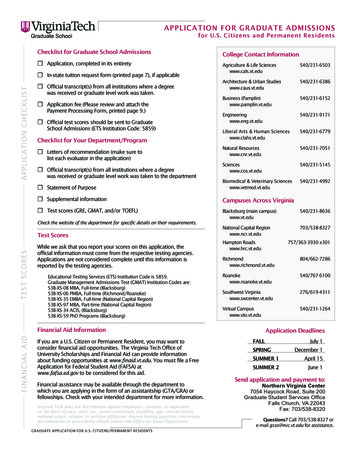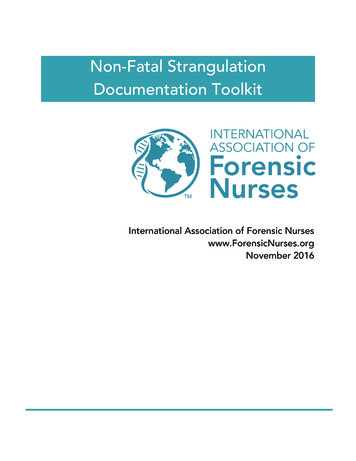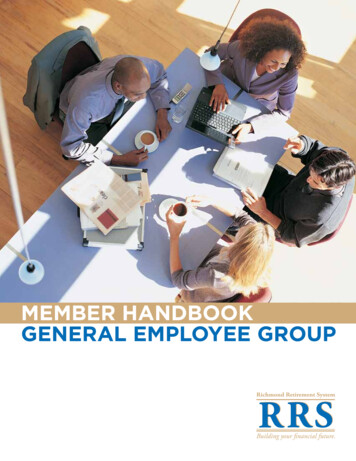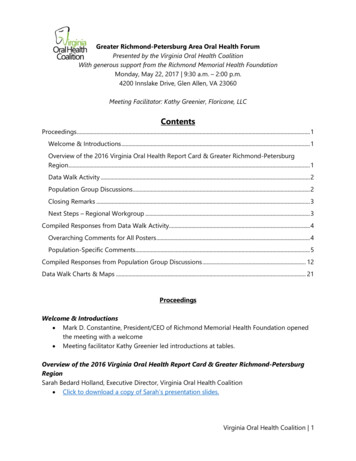
Transcription
Greater Richmond-Petersburg Area Oral Health ForumPresented by the Virginia Oral Health CoalitionWith generous support from the Richmond Memorial Health FoundationMonday, May 22, 2017 9:30 a.m. – 2:00 p.m.4200 Innslake Drive, Glen Allen, VA 23060Meeting Facilitator: Kathy Greenier, Floricane, LLCContentsProceedings . 1Welcome & Introductions . 1Overview of the 2016 Virginia Oral Health Report Card & Greater Richmond-PetersburgRegion. 1Data Walk Activity . 2Population Group Discussions. 2Closing Remarks . 3Next Steps – Regional Workgroup . 3Compiled Responses from Data Walk Activity. 4Overarching Comments for All Posters . 4Population-Specific Comments. 5Compiled Responses from Population Group Discussions . 12Data Walk Charts & Maps . 21ProceedingsWelcome & Introductions Mark D. Constantine, President/CEO of Richmond Memorial Health Foundation openedthe meeting with a welcome Meeting facilitator Kathy Greenier led introductions at tables.Overview of the 2016 Virginia Oral Health Report Card & Greater Richmond-PetersburgRegionSarah Bedard Holland, Executive Director, Virginia Oral Health Coalition Click to download a copy of Sarah’s presentation slides.Virginia Oral Health Coalition 1
Data Walk Activity Kathy invited participants to break into groups of three and provided instructions for theData Walk activity. The goal of this activity was to provide participants with a snapshot ofthe region’s oral health and prompt them to ask questions about what the data shows. The groups viewed posters with charts and maps of oral health data (click to jump to thecharts/maps). Each group member recorded their responses to a set of question prompts about thedata as they viewed the posters (click to jump to a detailed compilation of the data walkresponses). Highlights of participants’ responses:o Education is needed to increase awareness among Medicaid beneficiaries abouttheir coverage and options to help them get to appointments.o Providers, insurers, and community-based organizations have a role to play inhelping patients navigate the system to boost utilization and improve outcomes.o Many noted that Hispanics have higher utilization of services (among Medicaideligible children), but high rates of tooth decay; adults have low utilization ofservices, but low rates of tooth extractions. Many were curious about thisphenomenon and whether or not it is representative of the “immigrant paradox”(immigrants are healthier when they first arrive to US compared to latergenerations, implying that the structural environment of the US is unhealthy).o Many were alarmed by the racial/ethnic, income, and education disparities acrossall the indicators.o Many were surprised by the absence of Medicaid dental providers in Charles CityCounty, Surry County, and Sussex County, the low number of Medicaid dentalproviders in Petersburg, and the high number of providers in Emporia City.1When overlaid with other social/demographic data, it is clear that there are areasof need in Petersburg and Southside in particular.o Many noted a lack of data about specific populations such as pregnant womenand older adults, and a need for a breakout of all the dental health indicators bysex.o More granular data is needed to better understand areas of greatest need.Population Group DiscussionsDr. Maghboeba Mosavel, Virginia Commonwealth University, introduced the afternoon activity,and Kathy gave the instructions. Meeting attendees assigned themselves to different groups byThere is a high concentration of dentists in Emporia, presumably because it is a central location. Thereare no Medicaid dental providers in Charles City, Surry, or Sussex Counties. There may be a free clinic witha locum tenens dentist. The data used for these maps is based on Medicaid claims and only full-timeequivalent (FTE) dentists; locum tenens dentists are not included in that count.1Virginia Oral Health Coalition 2
population category: adults; children ages 0-5 and pregnant women; children and adolescentsages 6-18; individuals with special health care needs; and older adults. Each group responded toa set of two question prompts. Click here to jump to a summary of the discussions for eachpopulation group.Closing RemarksSarah (VaOHC) thanked attendees and reminded everyone that meeting materials (includinghandouts and powerpoints) will be shared after the meeting.Sarah encouraged attendees to fill out a sign-up sheet to get involved with a regionalworkgroup and/or one of VaOHC’s state-level workgroups.Next Steps – Regional Workgroup Complete doodle poll for regional workgroup interest meeting by Wednesday, June 14,2017.Join our email list to receive monthly updates.Contact Lauren Gray, VaOHC Program & Engagement Manager, to get involved in aregional workgroup: lgray@vaoralhealth.org or 804.299.5506.Virginia Oral Health Coalition 3
Compiled Responses from Data Walk ActivityOverarching Comments for All PostersWhat most surprises you about this data? Why? Coverage Access Utilization Expected a bigger gap between region and state for permanent molar sealantsWhat information is missing? Why is this missing information important? Awareness/education – are people aware of resources and services that can help? The “why’s” are missing. Why is there such a huge difference between the categories and why do Medicare packages noteinclude what they need for dental care? It’s important because without the why’s, one can only wonder versus understand. Percentage of cultural groups that go back to their countries to receive dental care. Why are families not accessing services? That would tell us what we need to do to inform families. Emergency department dental data. It would have been very informative to see how oral health (or the lack of it) follows the same pattern as other health problemsspecific to geographical areas. Information about the impact of nutrition on oral health. Information about cost to the systems – such as the cost associated with ED visits for preventable dental conditions or costs forextractions.Do these data help you understand oral health inequities in this region? Why or why not?Yes, because Good visual representation Already have knowledge of many of the disparities, yet seeing it charted and discussing it with the group is eye opening It also goes along with the County Health Rankings and how the inequalities are spread It highlights race and income differences It is wonderful to see the common issues of the region You can see the areas where poverty is, which causes inconsistent participation in oral health care especially for young children Side boxes are helpful The data demonstrate that as poverty level increases, oral health is negatively affected.No, because Average data can be misleading for disparitiesVirginia Oral Health Coalition 4
Are there correlations between certain indicators, especially among race/income/public program eligibility/disease status? Need to understand why disparities exist Need more information about culture and specific beliefs/traditionsWhat questions do you have about these data? How can we access these (online) to share with stakeholders?o All meeting handouts – including the data walk posters – will be posted to the Virginia Oral Health Coalition website:www.vaoralhealth.org. Who’s educating the community? How can people find funding? What are the resources? Are there transportation services available? Is the public aware? How do we get this information to policymakers? How will the data be used to advocate for better dental coverage at the federal, state, and local levels? How can we as dental team members help to educate the community about the availability of health coverage and what itcovers? I wonder what the barriers are that cause these outcomes. How was data gathered for certain populations?Population-Specific CommentsWhere comments were made about a specific chart or group of charts, the page number is listed in parentheses. Comments thatoverlapped were summarized rather than repeated.Adult Oral Health Bar ChartsChildren Oral Health Bar ChartsMedicaid Dental Provider MapsWhat most surprises you about this data? Why?All charts, pp. 26-34 Hispanic adults have lowerprevalence of extractions than otherracial/ethnic groupsAll charts, pp. 21-25 Covered individuals who do notreceive careAll maps, pp. 36-41 No Medicaid providers in CharlesCity County, Surry, or SussexVirginia Oral Health Coalition 5
Adults’ lack of access and coverageCovered individuals who do notreceive care So many places where “easy” andimportant services hover around 50%- they should be much higher.Percentage of Central Virginia Adults(18 ) Who Have Lost At Least One Toothto Decay/Disease, pp. 26-29 Surprised that 34% of high-incomeindividuals (making 50,000 annually) had lost at least one tooth(p. 26) High percentage of people withdiabetes who have lost at least onetooth compared to overallpercentage for region and state (p.28) 40% of college educated people inthe region have tooth loss, whichseems high. Are they not gettingcare? No insurance? (p. 27) So many individuals with less than ahigh school degree had lost at leastone permanent tooth (p. 27)Percentage of Central Virginia ThirdGraders with Tooth Decay by Free LunchStatus, p. 21 More children on free lunch neededurgent care, and more kids in CentralVirginia overall had urgent needcompared to statePercentage of Central Virginia Adults(18 ) with a Dental Visit in the Last Year,pp. 30-31 Surprised at the close percentage ofadults 18-44 and 65 , indicating thatthose folks pay out of pocket or havePercentage of Children (1-20) Enrolled inMedicaid/FAMIS with a Preventive DentalService by Age & Locality, p. 25 Under-utilization of Medicaid dentalfor children Low percentage of young children 12 utilizing care compared to 1-20Percentage of Children (1-20) Enrolled inMedicaid/FAMIS with Any Dental Visit byRace/Ethnicity, p. 24 Hispanic children have higher % ofdental visits that other racial/ethnicgroups in almost every locality in theregion and state overall How many Hispanics are receivingcare due to eligibility Under-utilization of Medicaid dentalfor children High number of Medicaid dentalproviders in EmporiaThere are more providers in someareas with low outcomes than youwould think – rural areas – Emporia.Not many providers (or none) inareas with high poverty.Medicaid Dental Providers by PercentPopulation Living in Poverty, p. 37 Percent of population living inpoverty was surprising – Sussex 25% pop. below 100% federalpoverty line (FPL) Areas like Petersburg & Dinwiddiehave high % of pop. in poverty, butlow number of Medicaid dentalprovidersMedicaid Dental Providers by TotalNumber of Uninsured Individuals (18 ), p.39 Surprised by the number of providersfor 18 in certain counties Urban areas appear to have moreuninsuredVirginia Oral Health Coalition 6
medical condition that promptspayment Percentage of Central Virginia Adults(18 ) with No Dental Coverage, pp. 32-34 Does 18-64 age group includepeople with Medicaid limitedbenefit? (p. 35) The older adults have a higherpercentage with no dental coverage(65 ). I thought Medicare did havesome type of coverage. We think it’s related to fixed income,even though issues now might beeven more expensive. Similar utilization rates across alllocalities for preventive dental careRural Goochland and Powhatan notseeming to utilize Medicaid benefitfor 1-2 year-old children – notsurprising, but would like to findways to encourage areas like this toseek care earlyAge break down between 1-20.Highlights important information anddifferentiation between age groups;i.e., a 5 y/o and a 19 y/o have verydifferent health factors affectingthem and their usage. Would alsoallow for more tailored intervention.Importance of education to familieswho qualify for Medicaid/FAMISWhat information is missing? Why is this missing information important?Pregnant Women Basic Screening Survey of WICPregnant Women not included in oralhealth data summary for CentralVirginia region. Pregnancy Risk Assessment &Monitoring Survey (PRAMS) data isself-reported and contains no dentalindicators (mentioned in oral healthdata summary).All charts, pp. 21-25 Pediatricians play a role – theireducation and recommendations toparents encourage early preventivevisits. Can Medicaid managed careorganizations (MCOs) impactpreventive visits? Need more data on ages 0-5.All maps, pp. 36-41 Where is the mirrored data as itrelates to medical Medicaidutilization? Does it compare? Medicaid providers by PCI –dental provider info missing forsome counties. Color coding notclear. Should overlay dental providerswith transportation availability.Third Grade Children, pp. 21-23Virginia Oral Health Coalition 7
Demographics Comparison by sex (men vs. women) It would be interesting to see wherethe utilization occurs byrace/ethnicity, which group(s) isimpacted, and what the opportunitiesare Detail breakdown on 65 population,more data on geriatric population ingeneral Oral health literacy Those children not participating inthe [Basic Screening Survey ofVirginia’s Third Grade Children]?Give trend dataLikelihood of second occurrence oftooth decay once first occurs. Caneducation be given after first?Would help to have comparison ofchildren at the school level – rural vs.urban schoolsWhat is the effect of nutrition/sugarybeverages?Medicaid Dental Providers by TotalNumber of Uninsured Individuals (18 ), p.39 Total number of 18 (%): this missesso many population differencesChildren in Medicaid/FAMIS, pp. 24-25 Breakdown of where care is beingprovided and who is providing care(private practice, public health clinics,free clinics, DDS/RDH, or in publicschools) Breakdown of Medicaid utilization byageDo these data help you understand oral health inequities in this region? Why or why not?Percentage of Central Virginia Adults(18 ) with a Dental Visit in the Last Year Dental visits lower for individuals withlower income level (p. 30)All charts, pp. 21-22 Disparity between kids on free andreduced lunch and those who arenot.All maps, pp. 36-41 Central region has greater need onmany posters for uninsured andproviders available Especially shocking to see thedisparity within Henrico – WesternHenrico has more access thanVirginia Oral Health Coalition 8
Percentage of Central Virginia Adults(18 ) Who Have Lost At Least One Toothto Decay/Disease Diabetes greatly increases risk oftooth loss (p. 28) Eastern and that pulls the wholecounty down. Why is there such adisparity within the county?Yes, but there is a lot going onunderneath, such as travel distances,population at base.What questions do you have about these data?Racial/Ethnic Disparities What is the role of the immigrantparadox (phenomenon where firstgeneration immigrants have betterhealth outcomes than their children)? What population of Hispanics reallyhave access to dental care? Does itinclude undocumented immigrants? What role do language/culturalbarriers play in access to dental carein the region? (E.g., do someHispanics not seek care due todocumentation status, afraid toregister or not understandingpaperwork?)Age Group Disparities How do adults 65 who have higherrates of being dentally uninsuredhave 68% with a dental visit in thelast year?All charts, pp. 21-25 Some charts specified a “dental visit”– were these preventive visits? Painvisits?Percentage of Children (1-20) Enrolled inMedicaid/FAMIS with Any Dental Visit byRace/Ethnicity, p. 24 Pie charts were a little confusing What population of Hispanics reallyhave access to dental care? What factors are behind Hispanicpercentage being highest forMedicaid usage? How does Medicaid utilizationbreakdown by age (not just 1-2 and1-20 age groups)? Is there more information for kidswith untreated decay? Why don’t more providers acceptMedicaid/FAMIS?All maps, pp. 36-41 Why so many Medicaid dentalproviders in Emporia? Do individuals living in Sussex andSurry travel to Emporia for care? Why are there such poor outcomesin Emporia if they have the mostMedicaid providers? If Petersburg has such pooroutcomes, how come we have thefewest Medicaid providers? How canwe get more provider/governmentfunding? How do you find dental providerswho accept Medicaid? Some acceptit but it’s not advertised.Medicaid Dental Providers by PercentNon-White Population, p. 36 I’m not sure what this is conveyingVirginia Oral Health Coalition 9
How do we provide additionalsupport for the elderly (retired)community?Dental Coverage Any info on employer-provideddental coverage in conjunction withincome level? Data on mobile oral health careproviders? Are there going to be initiatives toeducate parents to help themnavigate Medicaid system for theirchildren? This is not an easy process.Early Childhood Childcare at home vs. Early HeadStart data – oral health awareness?Training? Do we have data?Medicaid Dental Providers by TotalNumber of Uninsured Individuals (18 ), p.39 Uninsured individuals should berepresented by a percentage insteadof a count per locality to betterunderstand.Do these data remind you of any personal or client experiences/anecdotes that you’ve seen in your work? Please share, ifyou are comfortable. Years ago, I worked in an IntensiveCare Unit (ICU) where a youngAfrican American man was admittedwith breathing difficulty and a toothabscess. He ended up passing awayafter turning septic. So sad. – NurseAs a dentist at the only communityhealth center in Petersburg with adental department, I see on a dailybasis that folks have a hard timegetting in for an appointment. Soaccess is an issue. Folks in Petersburgcould really benefit from anotherdental provider or group that acceptsMedicaid. – Safety net clinic dentistWe know that seniors over 65 havelittle to no coverage. Need to Children of Hispanic origin(undocumented) have no access todental insurance, therefore dentalneeds are unmet. – Public schoolnurseWe struggle with kids 1-10. Drop-offafter age 8 is huge and visits by 1 aswell. – Safety net clinic dental providerParent wanting child to have dentalcare in school setting because shehad no access to care. – Mobiledental care providerI have had to transport clients toanother locality/health district forservice. – Home visiting serviceprovider I am always bothered with thedisparity between Western Henricoand Eastern Henrico. I didn’t see thatrepresented. – ResearcherVirginia Oral Health Coalition 10
improve that. They are all livinglonger and the need is there. –University administratorOne woman seen at an office visitused fake fingernails to serve as herfront teeth because she had noneand could not afford dental care. –Dental hygienist at senior livingcommunityIn my former job, I worked with adultclients (Medicaid) in need of dentalinsurance. Because they were unableto afford preventive dental care, theyended up having to have all teethpulled before the age of 40. –Medicaid agency employeeWhen presenting dental health andchronic disease info to seniors andcaretakers, 100% of comments andquestions are about coverage.Frustration about no Medicarecoverage for dental. – Healthdepartment employeeWe have different “younger adult”data that would contradict someethnicity data presented in certaindemographics. Probably due to blackand white races in health exchanges.– Dental hygienist at safety net clinic WIC education to pregnant womenand parents with infants aboutprevention and care – so importantto start early! – Local healthdepartment health educatorPreventive care during pregnancy formothers is a struggle. Consequently,health care must start with mothers.– Head Start programPregnant teens had coverage, buthad not accessed it until really urgentcare was needed. – Home visitingprogram managerI know I’m tired of seeing kids withmore metal in their mouths than warveterans who got hit with shrapnel. –Insurance company outreach personVirginia Oral Health Coalition 11
Compiled Responses from Population Group DiscussionsPrompt 1Taking into account the regional snapshot you saw, the context of your work and experience, relevant health indicators, and the uniqueneeds of your population:1. Identify one critical priority that, when addressed, will create enduring change for the oral health of your population. E.g.,“Increase the percentage of African American children in Greater Richmond and Petersburg who have dental sealants.”2. Frame that issue as an outcome statement; e.g., “By 2022, the sealant prevalence among African American third grade childrenwill improve by 5% in the Greater Richmond and Petersburg area.”Prompt 2Building on the priority you have been discussing, answer the following questions together:3. What is already working well in our region to address this priority issue?4. What is missing? If nothing is currently happening in this region, what examples elsewhere might inform our work?5. Identify 1 or 2 high-level strategies that address the barriers surrounding the priority you identified. These strategies can buildon existing efforts identified in question 3, or they can fill gaps addressed in question 4. E.g., “Identify school districts in theGreater Richmond and Petersburg area that would benefit from partnerships to implement school-based dental care.”Children ages 0-5 &pregnant women(group 1)1. Priority: Utilization of preventive dental visits and services (e.g. fluoride varnish) by young children is low.2. Outcome statement: By 2022, increase the number of Medicaid pediatric providers applying fluoridevarnish to 25% from baseline of 5% in 2014-2015.3. What is working well: Free CE re: fluoride varnish for all office staff Create a mechanism for referrals4. What is missing: Expansion of activities to address barriers like: limited provider education around options tointegrate oral health with medical (e.g., reimbursement available in Medicaid for fluoride varnish).5. Strategies:Virginia Oral Health Coalition 12
Children ages 0-5 &pregnant women(group 2)Increase awareness among families that kids and pregnant women have a comprehensive dentalbenefit in MedicaidEnsure pregnant women know dental care is safe and necessary during pregnancyIncrease utilization of the preventive dental benefit through medical-dental collaboration,incentives, and increased awareness of transportation services, etc.1. Priority: Pregnant women are unaware of the importance of oral health for young children; begins fromconception and continues after child is born.2. Outcome statement: By 2022, increase the percentage of pregnant women with a dental visit to 50%from a baseline of 44% in 2010-2011.3. What is working well: Programs targeting parentso Preterm birth classes at subsidized housing Resource Centerso Bootcamps for dads Co-located, integrated model of primary care, OB/GYN, and dental services (e.g. CrossOver freeclinic)4. What is missing: Baseline survey of pregnant moms’ knowledge/awareness of a) importance of oral health for selvesand young children, and b) services available (e.g. comprehensive Medicaid dental benefits) Additional use of informational materials (e.g., pamphlets, waiting room videos) Effective patient navigation services Financial incentives for providers (especially physicians in large health systems) to practice oralhealth integration, screening/assessment, prevention Tracking of the percentage of pregnant women that return for a follow-up visit after initial consult;roll off Medicaid benefits at 60 days post-partum5. Strategies: OB/GYN visitso Providers incorporating parent education on importance of mother’s dental visit and age 1dental visit for childVirginia Oral Health Coalition 13
Provider incentives through value-based payments for outcomes; currently most VBParrangements target older adults with chronic diseases rather than groups like pregnantwomen.o Integrate oral health into providers’ electronic health records (EHR)Culturally competent careo Education for providers to increase cultural competency to reduce language/cultural barriersPatient engagement and navigationo Streamline process to find providers – collaborate closely with Department of MedicalAssistance Services (DMAS)o Utilize community health workers (CHWs) and lay health promoterso Children ages 0-5 &pregnant women(group 3)1. Priority: Pregnant women – increase the utilization of dental services.2. Outcome statement: By 2020, increase by 5% the number of pregnant women who utilize dental services.3. What is working well: Community health workers to include early childhood home visitors, localcommunity action groups, resource centers (housing projects) and church health ministries.4. What is missing: Coordinated campaign focused on the utilization of dental benefits by pregnantwomen.5. Strategies: Identify areas for disseminating information (through PSAs) about utilization of dentalservices during pregnancy to include: churches, radio stations, community groups, OB/GYN providers, WIC,health departments.Children ages 0-5 &pregnant women(group 4)1. Priority: Increase the educational awareness among low-income Medicaid population. Barriers: findingproviders, training of students/residents, OB/GYN-dental provider connection, transportation.2. Outcome statement: By 2022, there will be a 25% increase in educational awareness among pregnantwomen about the Medicaid dental benefit and importance of dental care.3. What’s working well: Education of providers, such as OB/GYNs and childcare professions Pre-service training Home visiting education Educational pamphlets working (in dental safety net clinic)4. What’s missing:Virginia Oral Health Coalition 14
Online services (text-for-babies) DentaQuest – app to find providers5. Strategies: Identify online and other resources already available Identify partners like DentaQuest, Division of Childcare Utilize VDH Live Well site, Facebook, other social mediaChildren &adolescents ages 618 (group 1)1. Priority: Increasing preventive dental sealants among school-age children.2. Outcome statement: Every year for the next five years, have all parental consent for school-basedsealants in schools where free/reduced lunch is 50%.3. What is working well: Didn’t get to discuss.4. What is missing: Identify champions in schools like school nurses, superintendents, parent-teacher orgleadership5. Strategies: Foster collaboration within each school to make dental sealants a social norm (principals, nurses,teachers, parent-teacher organizations, etc.) Foster friendly competition within and between regions by sharing outcomes data that identifiesmost successful schools/counties and least successful (maybe with a prize; e.g., cash prize).Children &adolescents ages 618 (group 2)1. Priority: Ensure children entering kindergarten have dental exam and that families are educated aboutoral health importance and prevention practices.2. Outcome statement: By 2022, Code of Virginia regulations shall require children entering kindergarten tohave a dental exam and shall require all Virginia public school students grades 1-6 and their parents toreceive oral health education. (Education prevention & health-related complications.)3. What is working well: Didn’t get to discuss.4. What is missing: Help parents maneuver the barriers to get their kids to care Education/awareness – what age/when to go Health literacy – good brochures and flyers aren’t always enough; people need to be able tounderstand what they’re reading Population of 2nd generation immigrants don’t qualify for coverageVirginia Oral Health Coalition 15
Oral health is at the bottom of people’s list of prioritiesNo requirement for dental amongst other health requirements for entering school, and that overallhealth requirement only happens entering kindergarten5. Strategies Sealants, etc. should be attached to other school requirements Consent forms for schools need to be in several languages Need a mobile van at schools and in neighborhoods outside of normal dental office hours Add oral health to school lessons/get fluoride in schools Parent education and help navigating the system – kids at certain ages can take responsibility too Pass a law by:o Building a grassroots call for the law – poll parents at kindergarten registration day, etc.o Recruit providers as part of a
o Many were surprised by the absence of Medicaid dental providers in Charles City County, Surry County, and Sussex County, the low number of Medicaid dental . are no Medicaid dental providers in Charles City, Surry, or Sussex Counties. There may be a free clinic with a locum tenens dentist. The data used for these maps is based on Medicaid .
